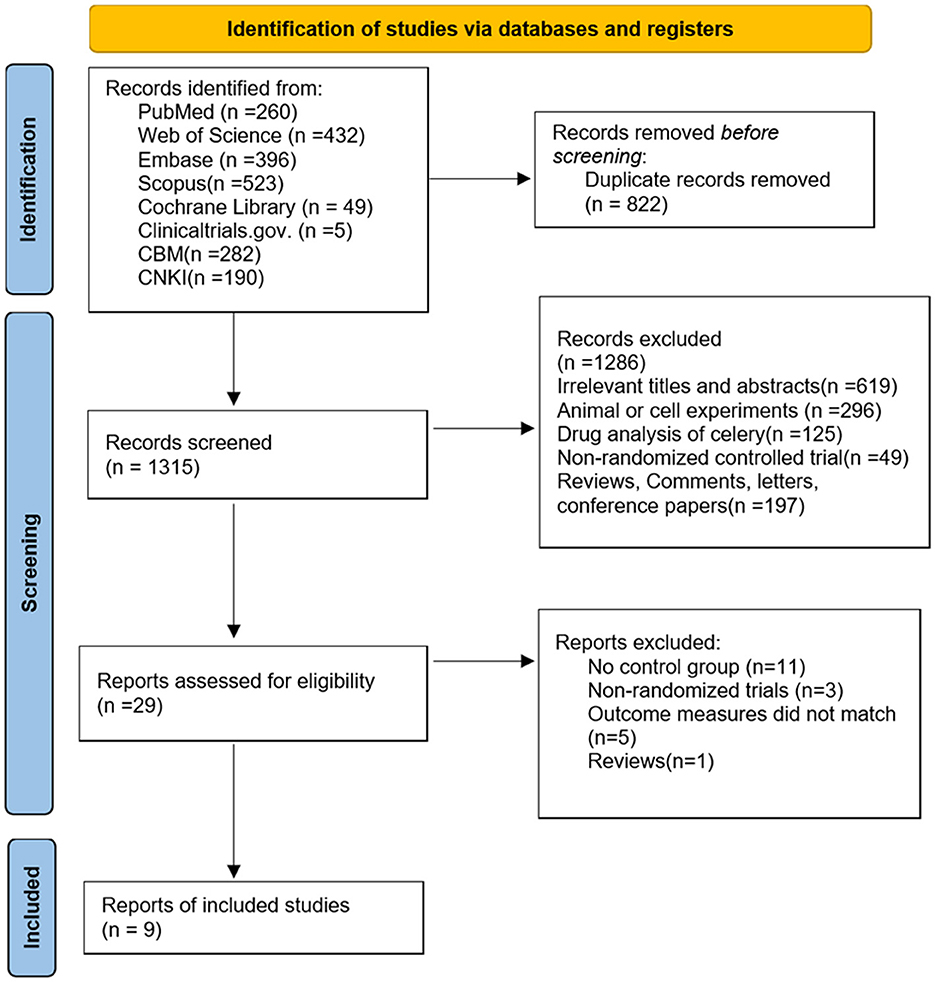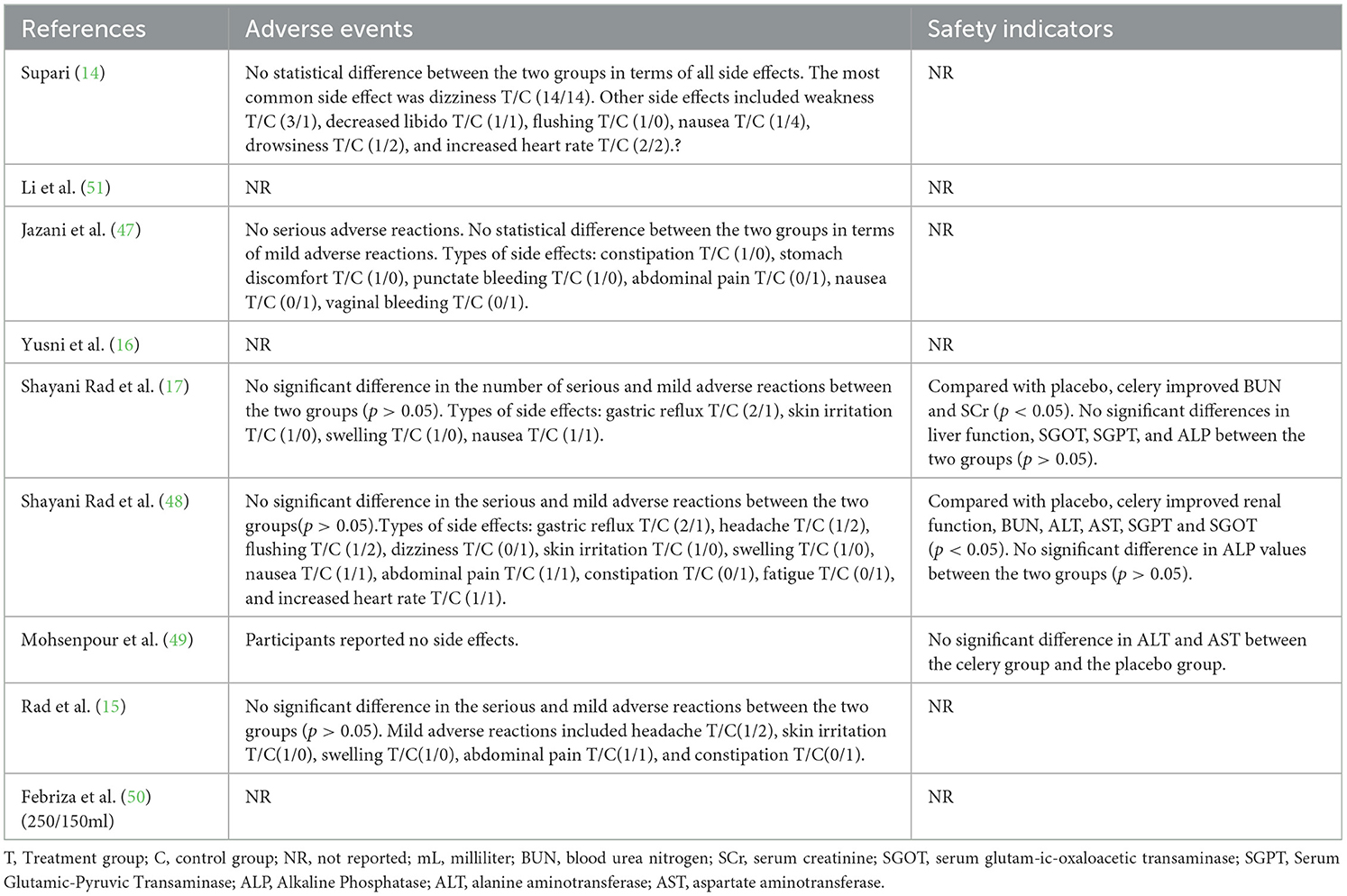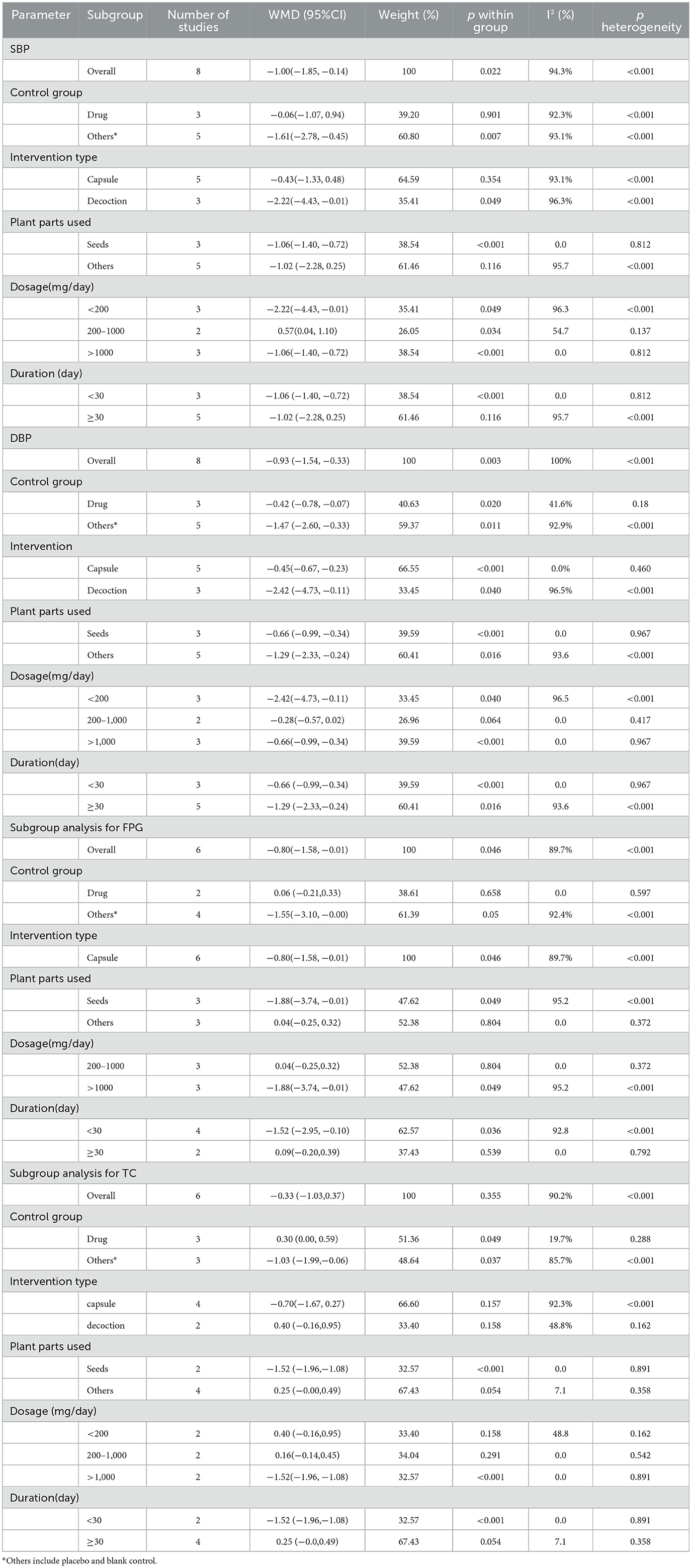- 1School of Basic Medical Sciences, Chengdu University of Traditional Chinese Medicine, Chengdu, China
- 2School of Third Clinical Medical, Nanjing University of Traditional Chinese Medicine, Nanjing, China
- 3School of Interdisciplinary Medicine, Tianjin University of Traditional Chinese Medicine, Tianjin, China
- 4State Key Laboratory of Dampness Syndrome of Chinese Medicine, The Second Affiliated Hospital of Guangzhou University of Chinese Medicine, Guangzhou, China
- 5XIN-Huangpu Joint Innovation Institute of Chinese Medicine, Guangzhou, China
Background: Celery is commonly used as a diet intervention for hypertension, hyperglycemia, and hyperlipidemia. However, its precise therapeutic efficacy remains uncertain.
Objective: This study aims to comprehensively evaluate the efficacy of celery preparations in regulating blood pressure, blood glucose, and blood lipids profiles in adults.
Methods: A systematic search was conducted in PubMed, Web of Science, EMBASE, Scopus, Cochrane Library, Clinicaltrials.gov, China Biology Medicine disc, and China National Knowledge Infrastructure. Randomized controlled trials of celery were included. Data were analyzed using either a random-effects model or a fixed-effects model, depending on heterogeneity, and were presented as standardized mean differences (SMDs) with corresponding 95% confidence intervals (CIs). All eligible studies were evaluated in terms of study characteristics, risk of bias, me-ta-analysis, sensitivity analysis, meta-regression, and publication bias.
Results: Our meta-analysis included ten randomized controlled studies with a total of 511 participants. The results demonstrated significant therapeutic effects of celery on systolic blood pressure (SMD: −1.0; 95% CI: −1.85 to −0.14), diastolic blood pressure (SMD: −0.93; 95% CI: −1.54 to −0.33), fasting plasma glucose (SMD: −0.80; 95% CI: −1.58 to −0.01), and triglyceride (SMD: −1.18; 95% CI: −1.45 to −0.91). However, no overall effects were observed on total cholesterol, low-density lipoprotein, or high-density lipo-protein. Subgroup analysis revealed that celery seeds or celery preparations exceeding 1,000 mg/day were more effective than other parts of celery. Additionally, no significant difference in adverse events between celery and placebo.
Conclusion: This meta-analysis demonstrated that Celery preparations significantly improve hypertension, hyperglycemia, and hyperlipidemia, with a favorable safety profile. Celery seeds or celery preparations exceeding 1,000 mg/day will have better effect. These findings suggest that celery performs well as a potential dietary supplement for reducing hypertension, hyperglycemia, and hyperlipidemia. However, the substantial heterogeneity observed for most outcomes and limited sample sizes warrant further high-quality clinical trials with longer follow-up periods to confirm these effects and establish optimal dosing regimens.
Systematic review registration: https://www.crd.york.ac.uk/PROSPERO/view/CRD42025631143, PROSPERO: CRD42025631143.
1 Introduction
Hypertension, hyperglycemia, and hyperlipidemia are interrelated conditions influenced by both genetic and environmental factors. Epidemiological data reveal alarming prevalence rates: hypertension affects approximately 1.28 billion individuals globally (1), with a prevalence of 40%−60% in developed countries (2). Hyperglycemia affects 9.1% of the global population (464 million people), and this figure is projected to rise to 10.0% (638 million) by 2045 (3). Hyperglycemia is often accompanied by lipid disorders (4) and acts synergistically with hypertension to elevate cardiovascular disease (CVD) risk. Compared with hypertension alone, their coexistence approximately doubles the risk of CVD (5), posing a significant burden on healthcare systems.
There is a growing interest in dietary interventions to complement conventional therapies and enhance their effectiveness. Celery, with its long-standing use in traditional medicine across various countries (6–8) and its unique phytochemical profile, has emerged as a promising candidate.
Apigenin, a bioactive compound in celery, exerts vasodilatory and antiproliferative effects on vascular smooth muscle cells, contributing to blood pressure reduction (69). Celery has also been demonstrated to effectively lower triglyceride and cholesterol levels in rat models (9, 10). Its flavonoids act as potent scavengers of reactive oxygen species, thereby reducing lipid peroxidation (11). Celery seed extract has been shown to regulate blood pressure through multiple mechanisms, including calcium channel blockade, β-adrenergic receptor inhibition, and diuretic activity (12).
3-n-butylphthalide, a compound present in celery seeds, has been found to improve insulin resistance and lower blood glucose levels (10). Both aqueous and ethanol extracts of celery seeds have shown lipid-lowering bioactivity in hamster models (13).
Several clinical studies support the above potential benefits. Clinical trials have also reported significant antihypertensive effects of celery (14, 15). For instance, a randomized trial conducted by Yusni et al. in prediabetic patients indicated that celery may reduce blood glucose levels (16). Additionally, randomized controlled trials have suggested that 1.34 g/day celery seeds contribute to lowering blood lipid levels (17).
Despite these promising findings, a comprehensive systematic review and meta-analysis of celery's effects on these parameters remains lacking. This study aims to systematically evaluate the evidence on the effects of celery on blood pressure, blood glucose, and lipid profiles, and to assess its safety profile to inform clinical practice.
2 Materials and methods
This study was conducted in accordance with the Preferred Reporting Items for Systematic Reviews and Meta-Analyses (PRISMA) guidelines (18) and has been registered in PROSPERO (Registration No.: CRD42025631143, https://www.crd.york.ac.uk/PROSPERO/display_record.php?RecordID=631143).
2.1 Search strategy
A systematic search was performed in PubMed, Web of Science, EMBASE, Scopus, Cochrane Library, ClinicalTrials.gov, China Biology Medicine disc, and the China National Knowledge Infrastructure from database inception to January 15, 2025. MeSH terms and free-text keywords were used as appropriate for each database. The detailed search strategy is provided in Supplementary material 1.
This study included publications in all languages. Two reviewers (D.L. and H.X.) independently conducted an initial screening of identified titles and abstracts to determine their eligibility, followed by a full-text review when necessary. To minimize the risk of missing relevant studies, reference lists of included articles and related reviews were manually checked. Study selection was performed independently by two reviewers (D.L. and H.X.) following the PICOS framework, and any discrepancies were resolved through consultation with a third reviewer (H.Z.). The PICOS criteria were defined as follows:
(1) Participants: Adults;
(2) Intervention: Celery;
(3) Control: Others;
(4) Outcomes: systolic blood pressure (SBP), diastolic blood pressure (DBP), fasting plasma glucose (FPG), triglycerides (TG), high-density lipoprotein cholesterol (HDL-c), low-density lipoprotein cholesterol (LDL-c), total cholesterol (TC), and safety information;
(5) Study design: Randomized controlled trials (RCTs).
2.2 Eligibility criteria
Inclusion Criteria: (1) Celery was used as the intervention. (2) A non-celery intervention was used as the control. (3) The study was a RCT. (4) Participants were adults (18 years old and above).
Exclusion Criteria: (1) Incomplete data. (2) Animal or cell-based experiments, study protocols, case reports. (3) Reviews, commentaries, conference papers or letters to the editor.
2.3 Data extraction and risk of bias assessment
Following the guidelines of the Cochrane Handbook for Systematic Reviews of Interventions (19), the following data were extracted:
(1) Study characteristics: first author, publication year, country, population, sample size, study design, and type of control group;
(2) Participant characteristics: mean age and sex distribution;
(3) Intervention and comparator details: intervention method, dosage, and duration;
(4) Outcome measurements: pre- and post-treatment mean and standard deviation (SD) for SBP, DBP, FPG, TC, HDL-C, LDL-C, and TG, or the mean difference and SD between pre- and post-treatment values.
The quality of included studies was assessed using the Risk of Bias 2 (RoB 2) tool recommended by the Cochrane Collaboration (20). The following domains were evaluated: randomization process, deviations from intended interventions, missing outcome data, measurement of the outcome, selection of the reported result, and overall bias. The certainty of evidence used the GRADE (Grading of Recommendations Assessment, Development and Evaluation) approach (21); detailed criteria are provided in Supplementary material 3.1.
2.4 Data synthesis and analysis
All statistical analyses were performed using STATA 17.0. Meta-analyses were conducted using post-treatment means and SDs when baseline characteristics showed no significant differences. If baseline differences were significant or not reported, the mean change and the SD of change were used instead. According to the Cochrane Handbook (22, 23), when the SD of change scores was not reported, it was calculated using the formula: . The r value is calculated using the following formula: . The estimated r values were 0.8 for statistically significant pre-post differences and 0.356618 for non-significant differences (24). For crossover trials with two treatment periods and a washout phase, only the first period (i.e., prior to the onset of the washout phase) data are included in the analysis. This approach is adopted to minimize the potential influence of carryover effects on the results.
Standardized mean differences (SMDs) with 95% confidence intervals (CIs) were used to assess treatment effects. Heterogeneity was evaluated using the I2 statistic, where an I2 value >50% indicated substantial heterogeneity (25). A random-effects model was applied when I2 >50%, whereas a fixed-effects model was used when I2 ≤ 50%. For subgroup analysis [conducted when at least six studies were available (26)], potential sources of heterogeneity and factors affecting the effect of celery treatment were explored based on type of control (pharmacological vs. other interventions), intervention duration (≥30 days), Celery dosage (< 500 mg/day, 500–1,000 mg/day, >1,000 mg/day), Celery part used (celery seeds vs. other parts). Meta-regression was conducted to assess the potential impact of plant part used, dosage, treatment duration, and gender distribution [male-dominant (≥60% male), female-dominant ( ≤ 40% male), and gender-balanced (40% < male proportion < 60%)] on outcomes and to identify sources of heterogeneity. Sensitivity analysis was performed to determine the influence of individual studies on the overall effect size. Publication bias was assessed using funnel plots, Egger's test, and the Begg-Mazumdar correlation test. If publication bias was detected, the “trim-and-fill” method was used for correction. A p-value < 0.05 was considered statistically significant in all analyses.
3 Results
3.1 Study selection
The process of literature screening was based on PRISMA guidelines (18) and is shown in Figure 1. We searched six databases, identifying 2,137 studies. After removing 822 duplicates, we excluded 1,286 studies based on title and abstract screening for the following reasons: irrelevant titles and abstracts (n = 619), animal or cell-based studies (n = 296), pharmacological analyses of celery (n = 125), non-randomized controlled trials (n = 49), and reviews, commentaries, letters (n = 197). The full texts of the remaining 29 articles were assessed for eligibility. Among the 29 articles, 3 studies were not RCTs (27–29), 11 studies lacked a control group (30–40), and 5 studies did not meet the predefined outcome criteria (41–45), which are therefore excluded. Additionally, one review article was excluded (46). Ultimately, nine studies comprising ten intervention groups were included (one study investigated two different doses of celery, analyzed as separate groups).
3.2 Study characteristics and drug safety
This meta-analysis is based on a total of nine randomized controlled trials published between 2002 and 2024, with studies conducted in Iran (15, 17, 47–50), Indonesia (14, 16), and China (51), with the majority originating from Iran. These trials involved participants with hypertension, polycystic ovary syndrome, prediabetes, or overweight conditions. The total sample size was 511 participants. Of the included studies, some were crossover trials (15, 17, 48), while the remaining studies employed parallel control design. Regarding study design, three trials used pharmacological control groups (47, 50, 51), while others used placebo or blank controls. One study had a mean participant age of 26.5 years (47), whereas in the remaining studies, the mean participant age ranged from 50 to 70 years. Among all studies, one trial exclusively recruited female participants (47), one study did not disclose gender distribution, and the remaining studies included both genders.
Celery was administered either as capsules or as decoctions, with capsule doses ranging from 10.55 mg to 2,250 mg per day, and treatment durations varying from 12 to 84 days. Among the ten included intervention groups, eight assessed SBP, eight evaluated DBP, six measured FPG and TC, four examined LDL-c, and three analyzed HDL-c and TG. Further inquiries were made to the corresponding authors via email regarding missing data, but no responses were received. The detailed characteristics of the included trials are presented in Table 1.

Table 1. Characteristics of included randomized controlled trials investigating celery interventions.
Regarding safety outcomes, six trials reported adverse events or safety outcomes associated with celery or placebo, while three studies did not provide safety information (16, 50, 51). Of these six trials, three reported only adverse events, whereas the other three reported both adverse events and safety-related laboratory parameters. No significant differences were observed between celery and placebo in terms of severe adverse events, and there was no notable difference in mild adverse events between celery and control groups. Given the wide variety but low frequency of reported adverse events, a descriptive analysis was performed. Comprehensive safety data details are provided in Table 2.
3.3 Risk of bias assessment
Among all included RCTs, only one study (47) exhibited a low risk of bias across all domains and was considered high-quality. In another study (14), the dropout rate exceeded 10%, with participants withdrawing due to perceived unsuitability of the intervention, leading to its classification as high-risk. The remaining studies are classified as having “some concerns.”
Among the nine studies, two were open-label trials (50, 51) while the others employed a double-blind design. Three studies explicitly employed block randomization (16, 47, 49), and an additional three utilized random number tables for allocation (15, 17, 48). The remaining studies did not provide detailed descriptions of their randomization methods, potentially impacting the risk of selection bias. Regarding allocation concealment, five studies adopted opaque packaging or sealed envelopes (15, 17, 47–49), while the others did not report allocation concealment procedures, thus limiting the assessment of potential bias in this domain. Details of the randomization and blinding methods are shown in Supplementary Table S2. The full results of the quality assessment are presented in Figure 2.
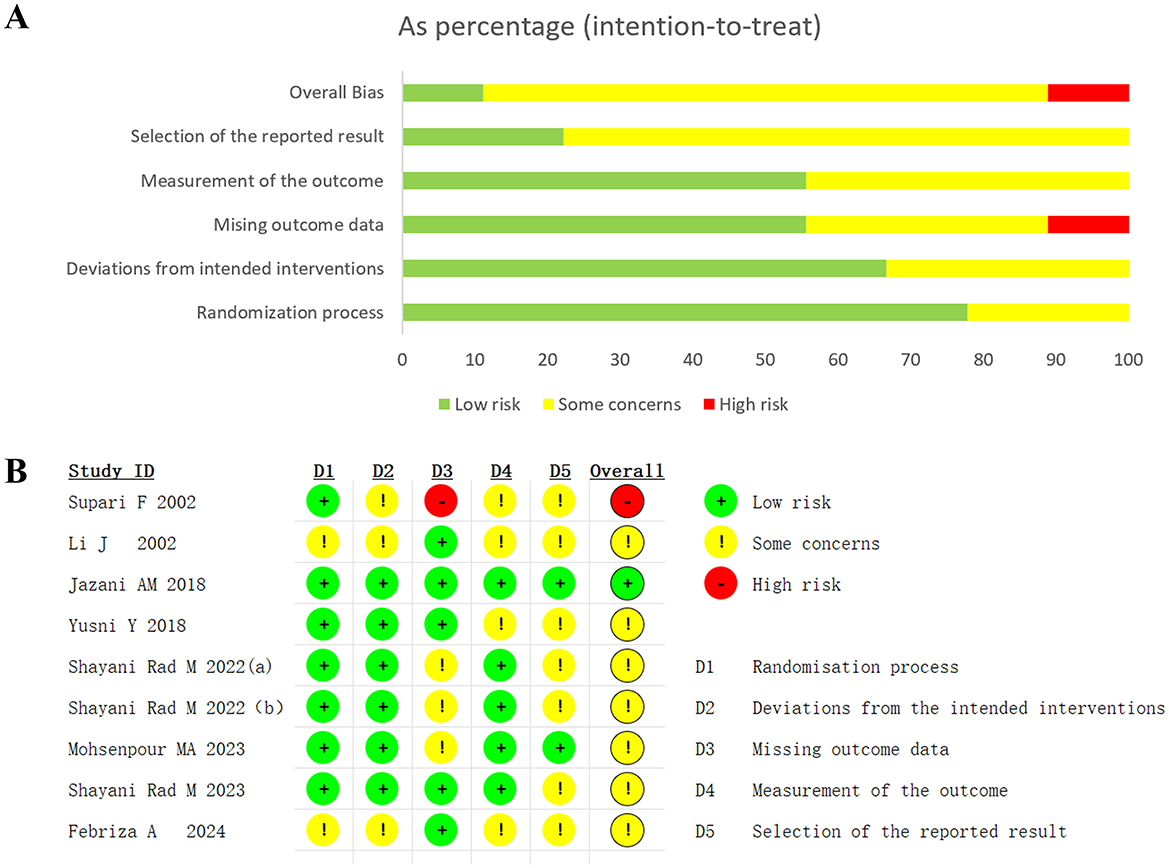
Figure 2. Summary plot of Cochrane Collaboration's risk of bias tool 2 of (A) Risk of bias summary. (B) Risk of bias diagram.
GRADE assessments (Supplementary Table S3.2) indicated that three outcomes were supported by high-quality evidence, including the non-pharmacological control subgroup for TG and HDL-C, and the pharmacological control subgroup for FPG. Moderate-quality evidence was identified for eight outcomes, including the non-pharmacological control subgroups for SBP, DBP, FPG, and TC, as well as the pharmacological control subgroups for TC, DBP, and HDL-C. Three outcomes were rated as low-quality evidence: the non-pharmacological control subgroup for LDL-C, and the pharmacological control subgroups for SBP and LDL-C. A total of 42.86% of outcomes were downgraded due to inconsistency, primarily driven by the high risk of bias and substantial heterogeneity in the study by Supari (14).
3.4 Meta-analysis
Eight studies (total sample size = 473) evaluated the efficacy of celery on SBP. The random-effects model revealed that, celery significantly reduced SBP levels compared to the control group (SMD: −1.0; 95% CI: −1.85 to −0.14; p = 0.022), with substantial heterogeneity (I2 = 94.3%, p < 0.001) (Figure 3A). Subgroup analysis indicated the medicinal part of celery, intervention dosage and intervention duration were the sources of heterogeneity (I2 has decreased to 0.0%). Meanwhile, subgroup findings indicated celery seeds were more effective than other parts of the plant. Additionally, shorter intervention durations (< 30 days) demonstrated greater efficacy (Table 3).
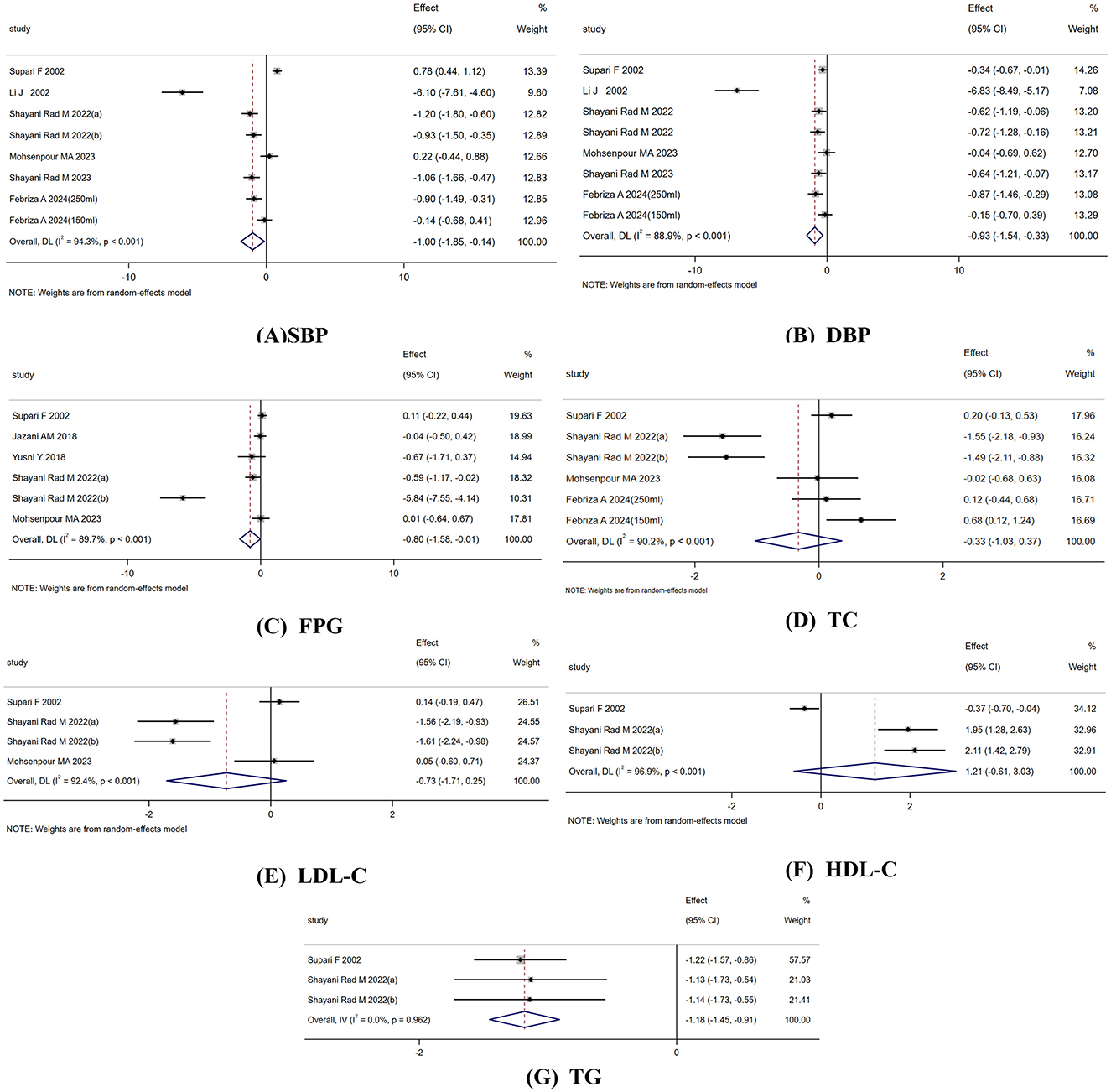
Figure 3. Forest plot reporting WMD and 95%CI for the effects of celery intake on (A) systolic blood pressure (SBP). (B) Diastolic blood pressure (DBP). (C) Fasting plasma glucose (FPG). (D) total cholesterol (TC). (E) Low-density lipoprotein cholesterol (LDL-c). (F) High-density lipoprotein cholesterol (HDL-c). (G) Triglycerides (TG).
Eight studies (total sample size = 473) assessed the impact of celery on DBP. The random-effects model showed that celery significantly reduced DBP levels compared to the control group (SMD: −0.93; 95% CI: −1.54 to −0.33; p = 0.003), with considerable heterogeneity (I2 = 88.9%, p < 0.001) (Figure 3B). Subgroup analysis found the medicinal part of celery, intervention type, intervention dosage and intervention duration were the sources of heterogeneity (I2 has decreased to 0.0%). Meanwhile, except for doses between 200 mg and 1,000 mg, which did not show a significant therapeutic effect, whereas all other subgroups exhibited a clear reduction effect (Table 3).
Six studies (total sample size = 369) analyzed the effect of celery on FPG. The random-effects model demonstrated a significant reduction in FPG levels compared to the control group (SMD: −0.80; 95% CI: −1.58 to −0.01; p = 0.046), with notable heterogeneity (I2 = 89.7%, p < 0.001) (Figure 3C). Subgroup analysis showed that heterogeneity decreased when stratified by control type, medicinal part of celery, intervention dosage, and intervention duration (I2 has decreased to 0.0%). Celery was more effective in lowering FPG when celery seeds were used, treatment duration was < 30 days, and dosage exceeded 1,000 mg/day.
Six studies (total sample size = 383) evaluated the effect of celery on TC. The random-effects model revealed no significant difference between celery and the control group (SMD: −0.33; 95% CI: −1.03 to 0.37; p = 0.355), with substantial heterogeneity (I2 = 77.4%, p < 0.001) (Figure 3D). Subgroup analysis showed a reduction in heterogeneity when studies were grouped based on medicinal part of celery, intervention dosage and intervention duration (I2 has decreased to 0.0%). Celery was more effective when celery seeds were used, the intervention lasted < 30 days, and the dosage exceeded 1,000 mg/day (Table 3).
Four studies (total sample size = 281) reported the effects of celery on LDL-C. Results from the random-effects model indicated no significant difference between celery and the control group (SMD: −0.73; 95% CI: −1.71 to 0.25; p = 0.146), with significant heterogeneity (I2 = 92.4%, p < 0.001) (Figure 3E).
Three studies (total sample size = 245) evaluated the impact of celery on HDL-C. The random-effects model showed no significant difference between celery intervention and placebo (SMD: 1.21; 95% CI: −0.61 to 3.03; p = 0.191), with considerable heterogeneity (I2 = 96.9%, p < 0.001) (Figure 3F).
Three RCTs (total sample size = 245) assessed the effect of celery on TG. The fixed-effects model indicated that celery significantly reduced TG levels compared to the control group (SMD: −1.18; 95% CI: −1.45 to−0.91; p < 0.001), with low heterogeneity (I2 = 0.0%, p = 0.962) (Figure 3G).
3.5 Sensitivity analysis
To determine the impact of each study on the overall effect size, a leave-one-out sensitivity analysis was conducted. Each study was excluded individually, and the overall effect sizes were recalculated. Our analysis revealed that no single study had a significant influence on the overall effect sizes of SBP, DBP, FPG, TC, LDL-C, or TG. In contrast, the sensitivity analysis for HDL-C indicated that the overall effect size was substantially influenced by the study conducted by Supari (14) (SMD: 7.61; 95% CI: 4.71 to 12.28) (Figure 4).
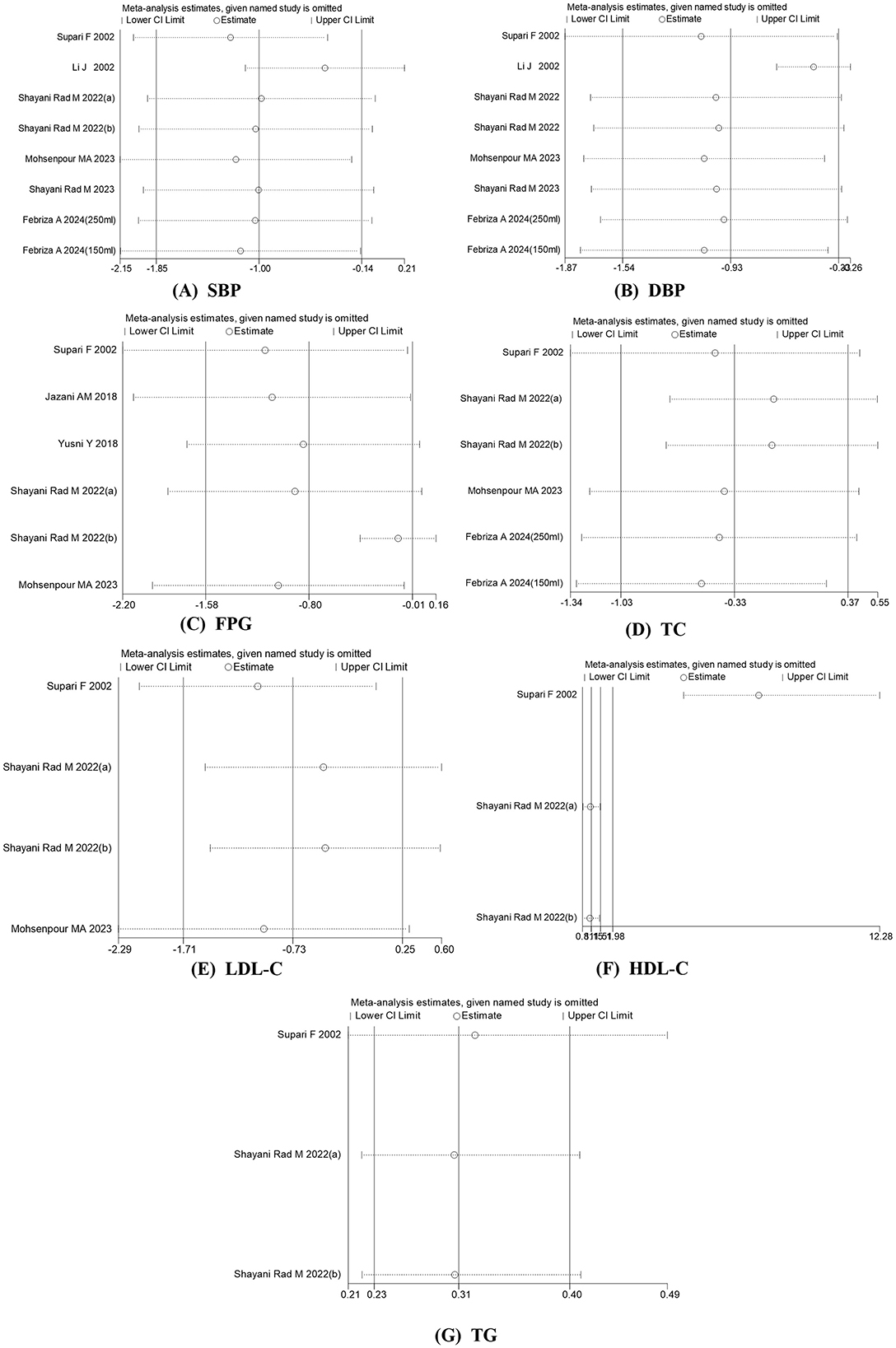
Figure 4. Sensitivity analysis was performed by removing each study in turn to determine the impact of each study on the overall effect size.
3.6 Meta-regression
To ensure the robustness of the findings and identify potential sources of heterogeneity, linear regression analysis was performed on outcomes with at least six studies to assess the effects of celery dosage and intervention duration. The analysis revealed no significant linear relationship between intervention duration and changes in SBP, DBP, FPG, or TC (p linear > 0.05, Figure 5). However, meta-regression indicated a significant negative linear relationship between intervention dosage and TC levels (Coef. = −0.00145, p linear = 0.012). This relationship was not significant for SBP, DBP, or FPG (Figure 6). In addition, DBP was significantly associated with gender (Coef. = 0.26, p = 0.047). The heterogeneity in TC was significantly related to the medicinal part of celery used (Coef. = −1.77, p = 0.002). No significant associations were observed between the plant part or gender stratification and other outcomes (Figures 7, 8).
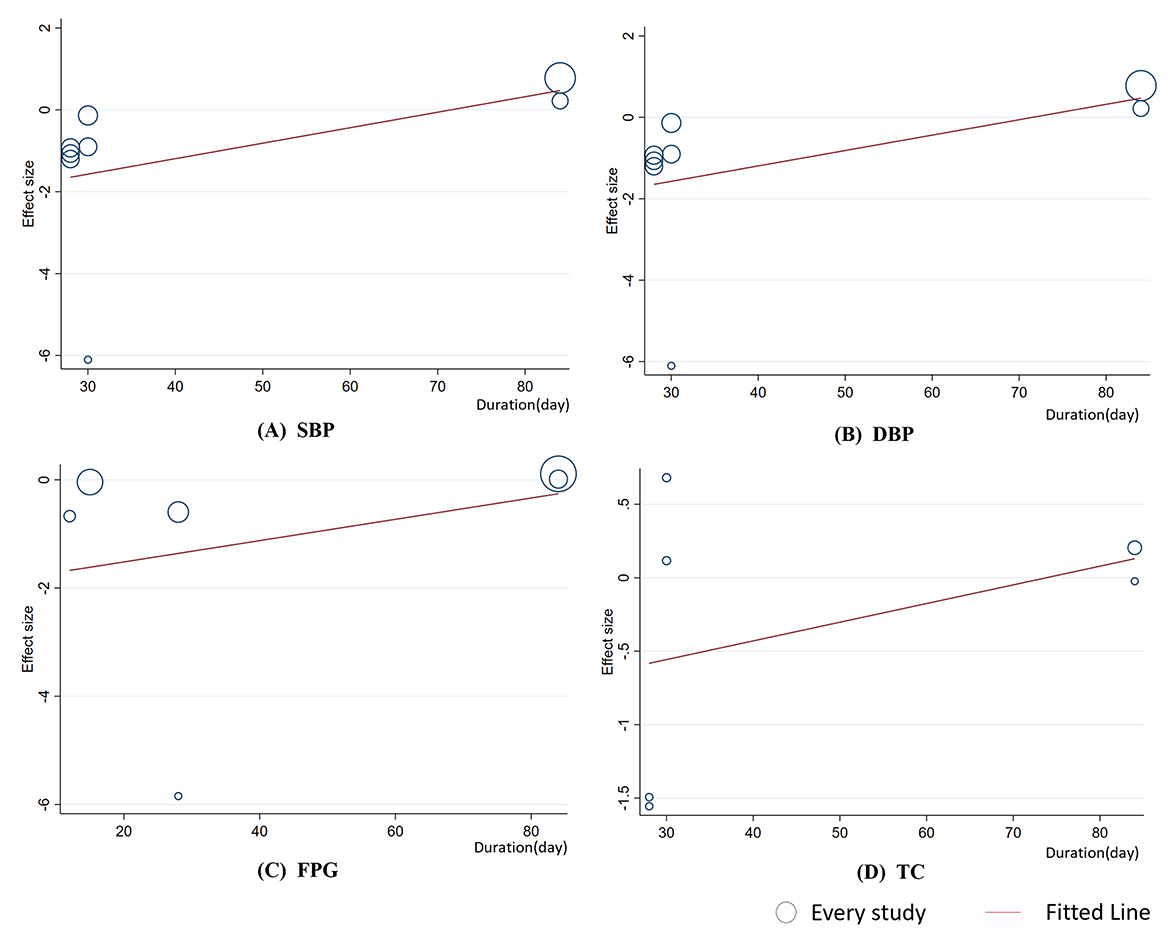
Figure 5. Meta-regression analysis between celery duration and mean difference in (A) SBP; (B)DBP; (C) FPG; (D) TC.
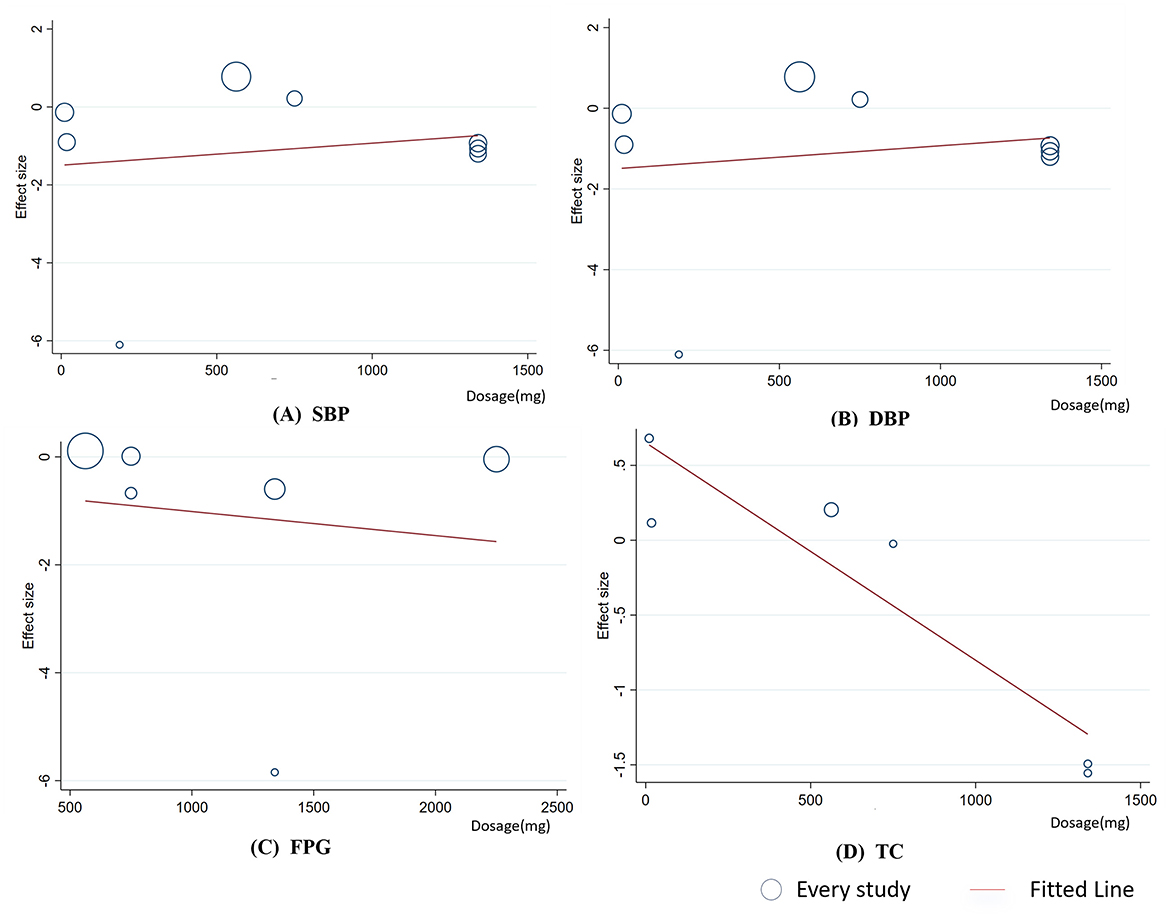
Figure 6. Meta-regression analysis between celery dosage and mean difference in (A) SBP; (B)DBP; (C) FPG; (D) TC.

Figure 7. Meta-regression analysis between gender and mean difference in (A) SBP; (B) DBP; (C) FPG; (D) TC. 0 indicates male-dominant studies, 1 indicates gender-balanced studies, and 2 indicates female-dominant studies.
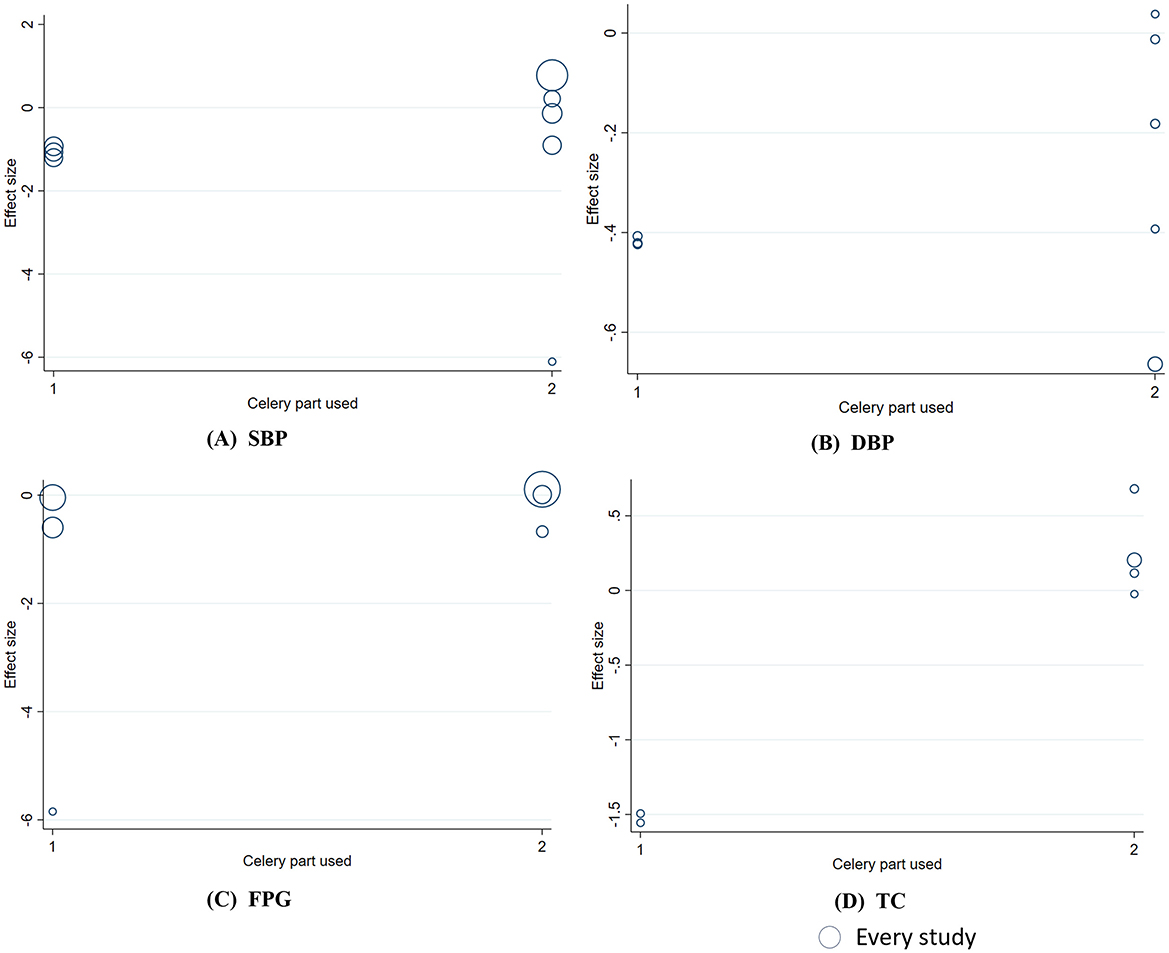
Figure 8. Meta-regression analysis between celery part used and mean difference in (A) SBP; (B) DBP; (C) FPG; (D) TC.1 indicates celery seeds, and 2 indicates other parts of the celery plant.
3.7 Publication bias
Potential publication bias was assessed using funnel plots, Egger's test, and Begg's test. Visual inspection of the funnel plots (Supplementary Figure S4.1) indicated some asymmetry. However, Egger's test and Begg's test (Supplementary Figures S4.2, S4.3) did not detect significant bias for DBP, FPG, TC, or LDL-C, suggesting stable effect estimates for these outcomes. For SBP, HDL-C, and TG, Begg's test did not indicate significant publication bias, but Egger's test suggested potential bias. Therefore, The Trim and Fill method was used for correction. The effect size after SBP correction was (SMD: −0.367; 95% CI: −0.867 to −0.157; p = 0.022), the effect size after HDL-C correction was (SMD: −0.691; 95% CI: −0.867 to 0.157; p = 0.686), and the effect size after TG correction was (SMD: −0.297; 95% CI: −0.307 to −0.236; p < 0.01).
4 Discussion
Systematic reviews and meta-analyses help assess the efficacy and safety of dietary supplements, providing valuable insights into their routine incorporation into the daily diets for cardiometabolic health management. Despite traditional use of celery in many cultures for health benefits (6–8), comprehensive evidence synthesis has been lacking. This systematic review and meta-analysis consolidate the latest evidence on the effects of celery on blood pressure, blood sugar, and blood lipid parameters, analyzing nine trials comprising ten studies with 511 participants. Our findings indicate that celery significantly reduces SBP (SMD: −1.0; 95% CI: −1.85 to −0.14; p = 0.022), DBP (SMD: −0.93; 95% CI: −1.54 to −0.33; p = 0.003), FPG (SMD: −0.80; 95% CI: −1.58 to −0.01; p = 0.046), and TG levels (SMD: −1.18; 95% CI: −1.45 to −0.91; p < 0.001), while effects on TC, LDL-C, and HDL-C were not statistically significant. Regarding safety, no significant difference was observed between celery and placebo in terms of adverse events.
Most studies and reviews support the blood potential pressure-lowering effects of celery (8, 15, 17, 46, 48). A recent clinical trial (50) found that adequate doses of celery can reduce blood pressure, which aligns with our meta-analysis. In contrast, Mohsenpour et al. (49) reported no significant difference between celery and placebo, underscoring the need for more studies to determine the true effect. Despite the challenge posed by these divergent findings, the significant pooled effect of celery on blood pressure remains noteworthy because even modest reductions in blood pressure may have substantial clinical significance. Epidemiological data from Japanese populations indicate that a sustained 2 mmHg reduction in average SBP can lower the incidence of stroke and ischemic heart disease by approximately 6% and 5%, respectively (52). A study by Dena Ettehad et al. further confirmed that even small decreases in blood pressure are associated with proportionate reductions in cardiovascular events, coronary heart disease, stroke, and heart failure (53). Therefore, in specific clinical settings, celery interventions may offer practical value. Additionally, as a low-cost and highly accessible complementary strategy, celery has the potential to help bridge treatment gaps in resource-limited regions.
Evidence regarding celery's hypoglycemic effect remains inconclusive. While some studies (17, 48) have reported significant glucose-lowering effects, others (47, 49) did not observe significant improvements. From a pharmacological perspective, celery seeds are rich in 3-butylphthalide, which can lower blood sugar levels and improve insulin tolerance (10). Although the pooled effect size for blood glucose in our study indicated a beneficial effect, the effect size was near the line of null effect, suggesting a marginally significant impact. Therefore, further large-scale, high-quality studies are needed to clarify the clinical relevance of celery's hypoglycemic action.
Clinical trials examining the effects of celery on lipid profiles are limited and show inconsistent results. Recent studies (47, 49) reported no significant impact on TC. However, studies by Shayani Rad et al. (17, 48) demonstrated that celery seeds significantly improved several lipid parameters, including TC, HDL-C, LDL-C, and TG. Animal and mechanistic studies provide additional evidence supporting celery's lipid-lowering potential. For instance, Ahmed (54) reported that celery seed improved lipid profiles, potentially through mechanisms such as inhibiting hepatic cholesterol synthesis, enhancing lecithin–cholesterol acyltransferase activity, and reducing intestinal lipid absorption. Zhao et al. (55) showed that fermented celery juice alleviated dyslipidemia and visceral fat accumulation in mice fed a high-fat diet. Other animal studies (56, 57) have shown that celery decreases serum LDL, TC, and TG levels. In our meta-analysis, celery significantly reduced triglyceride (TG) levels. However, no significant improvements were observed for TC, HDL-C, or LDL-C. Future research should focus on populations with specific dyslipidemias to better evaluate celery's effects on lipid profiles.
In addition, publication bias was detected in the significant outcomes of DBP and TG; however, the results remained statistically significant after adjustment using the trim-and-fill method. Nevertheless, these outcomes should still be interpreted with caution given the presence of publication bias.
Our subgroup and meta-regression analyses revealed several important patterns regarding intervention characteristics and efficacy:
1. Control intervention type: the therapeutic effects of celery varied depending on the type of control intervention. When compared with non-pharmacological interventions (e.g., Placebo and blank control), celery demonstrated significant therapeutic effects on blood pressure, FPG, and TC, highlighting its potential as a dietary intervention for prevention. For blood pressure outcomes, celery showed no statistically significant difference compared to pharmacologic treatments, and even demonstrated a greater reduction in DBP. Studies have shown that celery can induce vasodilation in aortic endothelial cells, potentially lowering blood pressure through mechanisms such as inhibition of receptor-operated and voltage-dependent calcium channels, release of endothelium-derived hyperpolarizing factors, and activation of voltage-dependent potassium channels (58).
2. Plant part used: subgroup analysis indicated that the therapeutic effects of celery differed by the plant part used. Interventions using celery seeds showed significant improvements in blood pressure, FPG, and TC. In contrast, preparations using other parts of the plant (e.g., stalks and leaves) only showed a significant reduction in DBP. Previous research demonstrates compositional differences among celery parts (6, 59–61). Celery seeds are rich in flavonoids, phthalides (e.g., sedanolide, 3-n-butylphthalide), and monoterpenes (e.g., limonene), whereas celery stalks and leaves contain higher levels of phenolic acids [e.g., chlorogenic acid and ferulic acid (62)], furanocoumarins (e.g., 5-hydroxy and 8-hydroxy methoxyfuranocoumarins), and flavonoids (e.g., apigenin, quercetin). These compounds may mediate distinct pharmacological actions: flavonoids may lower blood pressure and glucose via enzyme inhibition and antioxidant effects (63); phenolic acids are also associated with blood pressure regulation (64); furanocoumarins may exert antihypertensive effects through anti-inflammatory pathways. In celery seeds, the phthalide derivative CD21 has been shown to slow atherosclerosis progression and reduce hypertension by inhibiting AP-1 and NF-κB expression (65). Compared with celery stems and leaves, 3-butylphthalide, which is unique to celery seeds, can lower blood sugar levels and improve insulin tolerance, while inhibiting lipid accumulation and increasing free fatty acid uptake and oxygen consumption rate (10). Limonene activates the AMPK signaling pathway to regulate lipid metabolism (66). Collectively, differences in chemical composition may be one of the potential reasons for the varied effects observed among different parts of the celery plant. Meta-regression for the TC outcome confirmed that plant part was a source of heterogeneity, supporting differential efficacy based on the plant component used.
3. Dosage effects: our analysis showed that celery powder doses exceeding 1,000 mg per day were associated with greater efficacy. However, we also observed that doses below 200 mg per day also demonstrated significant therapeutic effects. Notably, these lower-dose interventions primarily involved celery decoctions rather than powdered celery. To ensure dose consistency, we standardized the decoction dose by converting it into an equivalent amount of celery powder. The decoctions were prepared by boiling fresh celery stalks and leaves. Thermal processing of fresh celery can disrupt plant cell walls, thereby enhancing the release and solubility of lipophilic compounds (67). Nevertheless, this standardization may not fully account for differences in phytochemical composition or bioavailability. The studies included in the low- and high-dose subgroups differed in several methodological and design aspects: low-dose studies primarily used other parts of the celery plant, while high-dose studies used celery seeds; low-dose studies were open-label, whereas high-dose studies were blinded. Therefore, the observed efficacy at low doses may be confounded by these differences and should be interpreted with caution.
4. Intervention duration: shorter intervention durations (< 30 days) showed better therapeutic effects, which may reflect physiological adaptation or metabolic tolerance with prolonged supplementation (68). This finding suggests that intermittent rather than continuous supplementation might optimize long-term benefits, a hypothesis requiring further investigation.
Some studies (17, 48) reported that celery consumption was associated with mild adverse events such as frequent urination, and gastrointestinal discomfort, although these effects were infrequent in clinical practice. Concerning safety, our study found no significant differences in overall adverse events or safety parameters between celery and placebo. The favorable safety profile suggests celery could be appropriate for long-term use as a dietary supplement.
In the GRADE assessment, the non-pharmacological control group demonstrated moderate to high-quality evidence for blood pressure and glycemic outcomes, with significant effects observed—supporting the potential metabolic benefits of celery intervention. However, evidence downgrades due to high heterogeneity highlight the need to reduce confounding factors. Meanwhile, the RoB 2 assessment identified one study (14) as having a high risk of bias, which directly contributed to the downgrading of GRADE ratings in five pharmacological control group outcomes. This suggests that the vulnerability of evidence in the drug-controlled subgroup is largely attributable to methodological shortcomings. Future research is encouraged to adhere strictly to the CONSORT guidelines, improve methodological reporting, and strengthen quality control.
Despite strict adherence to Cochrane guidelines for literature search and screening, this meta-analysis has some limitations:
(1) The studies included in this meta-analysis generally feature small sample sizes and are all conducted in Asian populations. Although the random-effects model help to some extent in adjusting for this situation, the generalizability of our conclusions may still be limited, particularly concerning potential influencing factors such as genetic background, age and dietary habits. Future research should focus on multi-center, large-scale studies in various geographic regions to validate the robustness of the findings.
(2) Considerable heterogeneity observed in key outcomes. Although our subgroup and meta-regression analyses partially accounted for this variation, some heterogeneity remained unexplained. This may be due to the multifactorial nature of heterogeneity sources and methodological differences across studies. Future research should aim to reduce heterogeneity through methodological standardization (such as celery preparation methods and dosage) and rigorous clinical implementation.
(3) Some studies lacked detailed descriptions of study design, randomization, and blinding, increasing the risk of potential bias.
5 Conclusion
Celery significantly improves SBP, DBP, FPG, and TG levels while having no significant effect on TC, HDL-C, or LDL-C, with a favorable safety profile. These findings suggest that celery may have potential value in modulating cardiometabolic parameters. In the prevention and management of clinically relevant conditions, healthcare professionals may consider appropriate supplementation strategies based on individual patient needs. Further research should focus on standardized preparations, defined patient populations, and optimal regimens regarding dosing to maximize long-term benefits.
Data availability statement
The original contributions presented in the study are included in the article/Supplementary material, further inquiries can be directed to the corresponding author.
Author contributions
DL: Visualization, Formal analysis, Writing – original draft, Data curation, Investigation. HZ: Writing – review & editing, Data curation. HX: Writing – review & editing, Data curation, Investigation. JH: Writing – review & editing, Conceptualization, Funding acquisition.
Funding
The author(s) declare that financial support was received for the research and/or publication of this article. This work was funded by Special Fund of State Key Laboratory of Dampness Syndrome of Chinese Medicine (SZ2021ZZ01) and the Top Scientist Studio Project based on the National Key Laboratory of Modern Chinese Medicine Creation (25JRRCRC00010).
Acknowledgments
We sincerely thank Dr. Meng Fei from City University of Hong Kong for providing topic discussion and language review support.
Conflict of interest
The authors declare that the research was conducted in the absence of any commercial or financial relationships that could be construed as a potential conflict of interest.
Generative AI statement
The author(s) declare that no Gen AI was used in the creation of this manuscript.
Publisher's note
All claims expressed in this article are solely those of the authors and do not necessarily represent those of their affiliated organizations, or those of the publisher, the editors and the reviewers. Any product that may be evaluated in this article, or claim that may be made by its manufacturer, is not guaranteed or endorsed by the publisher.
Supplementary material
The Supplementary Material for this article can be found online at: https://www.frontiersin.org/articles/10.3389/fnut.2025.1597680/full#supplementary-material
Abbreviations
CVD, cardiovascular disease; SMD, standardized mean difference; CI, confidence interval; TG, triglycerides; FPG, fasting plasma glucose; LDL-c, low-density lipoprotein cholesterol; HDL-c, high-density lipoprotein cholesterol; TC, total cholesterol; SBP, systolic blood pressure; DBP, diastolic blood pressure; RoB 2, Risk of Bias 2; RCT, Randomized controlled trial.
References
1. Krokstad S. Worldwide trends in hypertension prevalence and progress in treatment and control from 1990 to 2019: a pooled analysis of 1201 population-representative studies with 104 million participants (vol 398, pg 957, 2021). Lancet. (2022) 399:520–520. doi: 10.1016/S0140-6736(21)01330-1
2. Hisamatsu T, Miura K. Epidemiology and control of hypertension in Japan: a comparison with Western countries. J Hum Hypertens. (2024) 38:469–76. doi: 10.1038/s41371-021-00534-3
3. Rooney MR, Fang MC, Ogurtsova K, Ozkan B, Echouffo-Tcheugui JB, Boyko EJ, et al. Global prevalence of prediabetes. Diabetes Care. (2023) 46:1388–94. doi: 10.2337/dc22-2376
4. Lan JR, Zhao YY, Dong FX, Yan ZY, Zheng WJ, Fan JP, et al. Meta-analysis of the effect and safety of berberine in the treatment of type 2 diabetes mellitus, hyperlipemia and hypertension. J Ethnopharmacol. (2015) 161:69–81. doi: 10.1016/j.jep.2014.09.049
5. Liu J, Grundy SM, Wang W, Smith SC, Vega GL, Wu ZS, et al. Ten-year risk of cardiovascular incidence related to diabetes, prediabetes, and the metabolic syndrome. Am Heart J. (2007) 153:552–8. doi: 10.1016/j.ahj.2007.01.003
6. Sowbhagya HB. Chemistry technology, and nutraceutical functions of celery (Apium graveolens L.): an overview. Crit Rev Food Sci Nutr. (2014) 54:389–98. doi: 10.1080/10408398.2011.586740
7. Hedayati N, Bemani Naeini M, Mohammadinejad A, Mohajeri SA. Beneficial effects of celery (Apium graveolens) on metabolic syndrome: a review of the existing evidences. Phytother Res. (2019) 33:3040–53. doi: 10.1002/ptr.6492
8. Rizki O, Setyaningrum R. The use of celery (Apium graveolens L.) for reducing blood pressure in individual with hypertension in indonesia: a review paper. In Proceedings of the 4th International Conference Current Breakthrough in Pharmacy (ICB-Pharma 2022). Atlantis Press (2022). p. 261–268.
9. Yu HLJ. Animal experimental analysis of the lipid-lowering and health benefits of celery. Guizhou Med. (2004) 6:560–1. Available online at: https://kns.cnki.net/kcms2/article/abstract?v=mV2q5OJ_OLxH-UniJT56oai-0TZhOCciY9y7UfSqO4NnAjag33GgMGVohU_aFxm5CrT4-eXqN7mJef4cX8gsVbLnbgD2nPipl9ewfm370WhWlS5pmBfPk-pmG0dDW4g_dD0B1qloi2vHPu6i3WfRw7drv5Z-nfIG&uniplatform=NZKPT
10. Lu KY, Lin SZ, Primus Dass KT, Lin WJ, Liu SP, Harn HJ. 3-N-butylphthalide protects against high-fat-diet-induced obesity in C57BL/6 mice and increases metabolism in lipid-accumulating cells. Biomed Pharmacother. (2021) 139:111687. doi: 10.1016/j.biopha.2021.111687
11. Popovic M, Kaurinovic B, Trivic S, Mimica-Dukic N, Bursac M. Effect of celery extracts on some biochemical parameters of oxidative stress in mice treated with carbon tetrachloride. Phytother Res. (2006) 20:531–7. doi: 10.1002/ptr.1871
12. Tashakori-Sabzevar F, Ramezani M, Hosseinzadeh H, Parizadeh SMR, Movassaghi AR, Ghorbani A, et al. Protective and hypoglycemic effects of celery seed on streptozotocin-induced diabetic rats: experimental and histopathological evaluation. Acta Diabetol. (2016) 53:609–19. doi: 10.1007/s00592-016-0842-4
13. Lin LY, Ker YB, Chang CH, Chen KC, Peng RY. Arabinogalactan present in the mountain celery seed extract potentiated hypolipidemic bioactivity of coexisting polyphenols in hamsters. Pharm Biol. (2011) 49:319–26. doi: 10.3109/13880209.2010.516753
14. Supari S. Lowering blood pressure effect of Apium graviolens (Seledri) and orthosiphon stamineus benth (kumis kucing) in mild and moderate hypertension. Med J Indonesia. (2002) 11:195–201. doi: 10.13181/mji.v11i4.73
15. Rad MS, Moohebati M, Mohajeri SA. Beneficial effects of celery seed extract, as a supplement, on anxiety and depression in hypertensive patients: a randomized clinical trial. Inflammopharmacology. (2023) 31:395–410. doi: 10.1007/s10787-022-01083-y
16. Yusni Y, Zufry H, Meutia F, Sucipto KW. The effects of celery leaf (Apium graveolens L.) treatment on blood glucose and insulin levels in elderly pre-diabetics. Saudi Med J. (2018) 39:154–160. doi: 10.15537/smj.2018.2.21238
17. Shayani Rad M, Moohebati M, Mohajeri SA. Effect of celery (Apium graveolens) seed extract on hypertension: a randomized, triple-blind, placebo-controlled, cross-over, clinical trial. Phytother Res. (2022) 36:2889–907. doi: 10.1002/ptr.7469
18. Page MJ, McKenzie JE, Bossuyt PM, Boutron I, Hoffmann TC, Mulrow CD, et al. The PRISMA 2020 statement: an updated guideline for reporting systematic reviews. BMJ. (2021) 372:n71. doi: 10.1136/bmj.n71
19. Higgins JPT, Altman DG, Gotzsche PC, Jüni P, Moher D, Oxman AD, et al. The Cochrane Collaboration's tool for assessing risk of bias in randomised trials. BMJ. (2011) 343:928. doi: 10.1136/bmj.d5928
20. Sterne JAC, Savovic J, Page MJ, Elbers RG, Blencowe NS, Boutron I, et al. RoB 2: a revised tool for assessing risk of bias in randomised trials. BMJ. (2019) 366:4898. doi: 10.1136/bmj.l4898
21. Whaley P, Piggott T, Morgan RL, Hoffmann S, Tsaioun K, Schwingshackl L, et al. Biological plausibility in environmental health systematic reviews: a GRADE concept paper. Environ Int. (2022) 162:107109. doi: 10.1016/j.envint.2022.107109
22. Follmann D, Elliott P, Suh I, Cutler J. Variance imputation for overviews of clinical trials with continuous response. J Clin Epidemiol. (1992) 45:769–73. doi: 10.1016/0895-4356(92)90054-Q
23. Abrams KR, Gillies CL, Lambert PC. Meta-analysis of heterogeneously reported trials assessing change from baseline. Stat Med. (2005) 24:3823–44. doi: 10.1002/sim.2423
24. Önning G, Robertson A-K, Larsson N, van de Walle V, Boekhorst J. The effect of lactobacillus plantarum onstmptoms and the microbiome in subiects with irritablebowel syndrome. United Eur Gastroenterol J. (2020) 8:680. doi: 10.1177/205064061985467
25. Higgins JPT, Thompson SG, Deeks JJ, Altman DG. Measuring inconsistency in meta-analyses. BMJ. (2003) 327:557–60. doi: 10.1136/bmj.327.7414.557
26. Fe RW, Gartlehner G, Grant M, Shamliyan T, Sedrakyan A, Wilt TJ, et al. Conducting quantitative synthesis when comparing medical interventions: AHRQ and the effective health care program. J Clin Epidemiol. (2011) 64:1187–97. doi: 10.1016/j.jclinepi.2010.08.010
27. Samaha AA, Fawaz M, Salami A, Baydoun S, Eid AH. Antihypertensive indigenous lebanese plants: ethnopharmacology and a clinical trial. Biomolecules. (2019) 9:292. doi: 10.3390/biom9070292
28. Simamora L, Br Pinem S, Batu Bara Z. The comparison study of celery leaves in juice and celery boiled water to reduce of blood pressure on elderly patients with hypertension. In: Proceedings of the First International Conference on Health, Social Sciences and Technology (ICoHSST 2020) (2021). p. 2352–5398.
29. Erisandi TD. The difference of celery leaves and bay leaves water to decrease blood pressure among pre-elderly with primary hypertension in public health center cigugur tengah. Compr Nurs J. (2021) 7.
30. Hongen C. Celery juice for the treatment of 16 cases of hypertension. Fujian J Tradit Chinese Med. (1960) 07:42.
31. Yang B, Senlin X, Yunsheng P. Celery seed treatment for 25 cases of hypertension. Guangxi J Tradit Chinese Med. (1983) 05:48.
32. Zhang Jie XJ. Celery root treatment for 70 cases of arteriosclerotic hypertension. China's Naturop. (2002) 01:57. Available online at: https://kns.cnki.net/kcms2/article/abstract?v=mV2q5OJ_OLxp7qFUGcoglX084B_Lfahh8uftzKxBNjLlBSyMgwLqaTsXs7f7jOeCyMquCs-B77J0HH7jJvwWGcXmr9Amp3OORwU-tkQDtUr0djGUiLi3L9kLjpE2p0uVupvcZa4-LZ1uHfqGMhUolgWs9KXRv9yf&uniplatform=NZKPT
33. Wang YSZ, Zheng C. Celery treatment for 80 cases of primary hypertension. China's Naturop. (2003) 07:57–8. Available online at: https://kns.cnki.net/kcms2/article/abstract?v=mV2q5OJ_OLxpfvg_8qnOz0hN1zkFhTENWtDpvftxsr1_Am4yte0FCpz8uFeQqpdPEWSv-odEq7vPYhJnR5zsqBFhz71lRb2hBfHPzzbVNmchdudWqXQvzmDRcdXqUluGJ-5mOLMfcmi8cm_7Kmkp651ddr0bT1It&uniplatform=NZKPT
34. Cheng G. Celery extract for the treatment of 82 cases of primary hypertension. China Med Herald. (2007) 24:50–1. Available online at: https://kns.cnki.net/kcms2/article/abstract?v=mV2q5OJ_OLzBXlAjnmcDaAM2zJ0J0mrQdOobiDmzKwk1kQCZZhSMt_LFQITcxX1SuhDTLwT2Gx-cLgOGMFMWJyMp7j6dWV8OnWaORO8HehaksAG4o3Tn4UX8ukIi-nhwmhv7dcRdGur6vFO7Yxk9advfU2wX7evl&uniplatform=NZKPT
35. Dewi K, Krisanti Jasaputra D, Litanto O. The effect of celery ethanol extract (Apium graveolens L.) on male adult's blood pressure. J Plant Med. (2010) 1:27. Available online at: https://text-id.123dok.com/document/zlgl82gy-the-effect-of-celery-ethanol-extract-apium-graveolens-l-on-male-adult-s-blood-pressure.html
36. Indarti ET, Wilda LO, Nuvitasari Y. Water boiling celery affects blood pressure in elderly with hypertension. J Quality Public Health. (2020) 4:33–7. doi: 10.30994/jqph.v4i1.147
37. Indarti ET, Bhakti SS, Wilda LO, Nuvitasari Y. Community empowerment in the use of celery plant (Apium graveolens l) as an antihypertension in patihan village, sidoharjo district, sragen. Am Heart J. (2020) 4:552–8.
38. Simamora L, Sembiring NMPBr, Fithr N. The effectiveness of celery juice to reduce blood pressure on elderly with hypertension in the simalingkar health center. J Health. (2021) 38:469–476. Available online at: https://media.neliti.com/media/publications/434504-the-effectiveness-of-celery-juice-to-red-42c145d6.pdf
39. Simamora L, Sembiring NMPBr, Sinaga A. The effectiveness of celery boiled water on lowering blood pressure in the elderly with hypertension in the working area of the simalingkar public health center in 2020. Int J Midwifery Res. (2022) 38:469. doi: 10.47710/ijmr.v2i1.26
40. Dolang MW, Dinopawe A, Ohorella F, Bugis DA, Mahmud PE, Wakano M, et al. Administration of boiled celery water to reduce blood pressure in hypertensive patients during the COVID-19 pandemic. Multidisc Sci J. (2024) 38:469–76. doi: 10.31893/multiscience.2025164
41. Nahid K, Fariborz M, Ataolah G, Solokian S. The effect of an Iranian herbal drug on primary dysmenorrhea: a clinical controlled trial. J Midwifery Womens Health. (2009) 54:401–4. doi: 10.1016/j.jmwh.2008.12.006
42. Jinghua L. Clinical observation on the intervention of 50 cases of hypertension with diet and health guidance combined with antihypertensive formula. J Pract Tradit Chinese Med. (2015) 29:50–2. doi: 10.13729/j.issn.1671-7813.2015.02.23
43. Gorji NE, Farzanegi P, Habibian M, Mahdirejei HA, Abadei SF. Celery as an effective supplement for pilates exercise in weight loss studies. Int Med J. (2015) 54:401–4. Available online at: https://webvpn.zjnu.edu.cn/https/77726476706e69737468656265737421e7e056d2343367406b1bc7af9758/pages/publications/84935421318
44. Azizah NCN, Astuti D, Fanani Z, Karyati S, Kurnia W. The influence of celery juice againts blood pressure reduction in hypertensio. J Phys. (2020) 1477:76. doi: 10.1088/1742-6596/1477/6/062009
45. Rauf EL, Djunaid U, Umar S. The influence of giving celery juice combinating of carrots and honey to reduce hypertension at menopause the work area of telaga biru health centre. Media Publikasi Promosi Kesehatan Indonesia. (2022) 5:428–34. doi: 10.56338/mppki.v5i4.2217
46. Illes J, Rodrigues J. The influence of celery (Apium graveolens) juice on hypertension. in Reference Series in Phytochemistry (2025). p. 501–523. doi: 10.1007/978-3-031-38663-3_72
47. Jazani AM, Nazemiyeh H, Tansaz M, Bazargani HS, Fazljou SM, Azgomi RN, et al. Celery plus anise versus metformin for treatment of oligomenorrhea in polycystic ovary syndrome: a triple-blind, randomized clinical trial. Iranian Red Crescent Med J. (2018) 20:5. doi: 10.5812/ircmj.67181
48. Shayani Rad M, Moohebati M, MohammadEbrahimi S, Motamedshariaty VS, Mohajeri SA. Safety evaluation and biochemical efficacy of celery seed extract (Apium graveolens) capsules in hypertensive patients: a randomized, triple-blind, placebo-controlled, cross-over, clinical trial. Inflammopharmacology. (2022) 30:1669–84. doi: 10.1007/s10787-022-00986-0
49. Mohsenpour MA, Samadani M, Shahsavani Z, Golmakani MT, Pishdad GR, Ekramzadeh M. The effect of celery (Apium graveolens) powder on cardiometabolic factors in overweight/obese individuals with type 2 diabetes mellitus: a pilot randomized, double-blinded, placebo-controlled clinical trial. Food Sci Nutr. (2023) 11:5351–63. doi: 10.1002/fsn3.3493
50. Febriza A, Fitriani T, Hapsari BK. Effectiveness of consuming celery leaf decoction (Apium graveolens) in reducing cholesterol levels, blood pressure, and mean arterial blood pressure (MAP). In: AIP Conference Proceedings (2024). doi: 10.1063/5.0218057
51. Li J, HD, Liu H. Observation on the therapeutic effect of celery and black jujube soup on hypertension. Sichuan Tradit Chinese Med. (2002) 6:33–34. Available online at: https://kns.cnki.net/kcms2/article/abstract?v=mV2q5OJ_OLzzwYljM-ZcLt1GJ1HlDmQSIEhfDHOh-V1ELVkfrs54QqX6CpLGDk67Kb8gN6nPJK-wg9qfJCOZnjd9fjB2czuClMCkotWOqFrNepz3T1zRYJ36z_mTGwafVPlna5VBP-pED6UTOPQOUddFg38KgwrQ&uniplatform=NZKPT
53. Ettehad D, Emdin CA, Kiran A, Anderson SG, Callender T, Emberson J, et al. Blood pressure lowering for prevention of cardiovascular disease and death: a systematic review and meta-analysis. Lancet. (2016) 387:957–67. doi: 10.1016/S0140-6736(15)01225-8
54. Kim MA, Lee HJ, Bae HG, Yang SO, Lee HJ, Kim MJ. Metabolite analysis and anti-obesity effects of celery seed in 3T3-L1 adipocytes. Food Sci Biotechnol. (2021) 30:277–86. doi: 10.1007/s10068-020-00866-9
55. Zhao D, Cao J, Jin H, Shan Y, Fang J, Liu F. Beneficial impacts of fermented celery (Apium graveolens L.) juice on obesity prevention and gut microbiota modulation in high-fat diet fed mice. Food Funct. (2021) 12:9151–9164. doi: 10.1039/D1FO00560J
56. Cheng MC, Ker YB, Yu TH, Lin LY, Peng RY, Peng CH. Chemical synthesis of 9(Z)-octadecenamide and its hypolipidemic effect: a bioactive agent found in the essential oil of mountain celery seeds. J Agric Food Chem. (2010) 58:1502–8. doi: 10.1021/jf903573g
57. Iyer D, Patil UK. Effect of chloroform and aqueous basic fraction of ethanolic extract from Apium graveolens L. in experimentally-induced hyperlipidemia in rats. J Complement Integr Med. (2011) 8:1529. doi: 10.2202/1553-3840.1529
58. Sohrabi F, Niazmand S, Mahmoudabady M, Niazmand MJ. The vasodilatory effect of Apium graveolens L (celery) seed in isolated rat aorta: the roles of endothelium, calcium and potassium channels. Avicenna J Phytomed. (2021) 11:44–53.
59. Lombaert GA, Siemens KH, Pellaers P, Mankotia M, Ng W. Furanocoumarins in celery and parsnips: method and multiyear Canadian survey. J AOAC Int. (2001) 84:1135–43. doi: 10.1093/jaoac/84.4.1135
60. Kowalczyk A, Bodalska A, Miranowicz M, Karłowicz-Bodalska K. Insights into novel anticancer applications for apigenin. Adv Clin Exp Med. (2017) 26:1143–6. doi: 10.17219/acem/41978
61. Li MY, Hou XL, Wang F, Tan GF, Xu ZS, Xiong AS. Advances in the research of celery, an important Apiaceae vegetable crop. Crit Rev Biotechnol. (2018) 38:172–83. doi: 10.1080/07388551.2017.1312275
62. Liu DK, Xu CC, Zhang L, Ma H, Chen XJ, Sui YC, et al. Evaluation of bioactive components and antioxidant capacity of four celery (Apium graveolens L.) leaves and petioles. Int J Food Propert. (2020) 23:1097–1109. doi: 10.1080/10942912.2020.1778027
63. Zhang C, Yu J, Tu Q, Yan F, Hu Z, Zhang Y, et al. Antioxidant capacities and enzymatic inhibitory effects of different solvent fractions and major flavones from celery seeds produced in different geographic areas in China. Antioxidants. (2022) 11:1542. doi: 10.3390/antiox11081542
64. Rashmi HB, Negi PS. Phenolic acids from vegetables: a review on processing stability and health benefits. Food Res Int. (2020) 136:109298. doi: 10.1016/j.foodres.2020.109298
65. Lei W, Deng YF, Hu XY, Ni JN, Jiang M, Bai G. Phthalides, senkyunolide A and ligustilide, show immunomodulatory effect in improving atherosclerosis, through inhibiting AP-1 and NF-κB expression. Biomed Pharmacother. (2019) 117:109074. doi: 10.1016/j.biopha.2019.109074
66. Liao JT, Huang YW, Hou CY, Wang JJ, Wu CC, Hsieh SL. D-limonene promotes anti-obesity in 3T3-L1 adipocytes and high-calorie diet-induced obese rats by activating the AMPK signaling pathway. Nutrients. (2023) 15:267. doi: 10.3390/nu15020267
67. Yong L, Weidong Z, Hui S, Zhifeng Y, Yinhao??? X. Research on wet grinding processing technology of instant celery and vegetable powder. Agric Mach. (2012) 15:137–139. doi: 10.16167/j.cnki.1000-9868.2012.15.031
68. Cao RY, Zheng Y, Zhang Y, Jiang L, Li Q, Sun W, et al. Berberine on the prevention and management of cardiometabolic disease: clinical applications and mechanisms of action. Am J Chin Med. (2021) 49:1645–66. doi: 10.1142/S0192415X21500762
Keywords: celery, meta-analysis, lipid profile, blood pressure, glycemic
Citation: Liu D, Zhao H, Xu H and Hu J (2025) Effects of celery (Apium graveolens) on blood pressure, glycemic and lipid profile in adults: a systematic review and meta-analysis of randomized controlled trials. Front. Nutr. 12:1597680. doi: 10.3389/fnut.2025.1597680
Received: 21 March 2025; Accepted: 30 June 2025;
Published: 22 July 2025.
Edited by:
Yifan Huang, Soochow University, ChinaReviewed by:
Guangdong Wang, First Affiliated Hospital of Xi'an Jiaotong University, ChinaPatrick Maduabuchi Aja, Kampala International University Western Campus, Uganda
Copyright © 2025 Liu, Zhao, Xu and Hu. This is an open-access article distributed under the terms of the Creative Commons Attribution License (CC BY). The use, distribution or reproduction in other forums is permitted, provided the original author(s) and the copyright owner(s) are credited and that the original publication in this journal is cited, in accordance with accepted academic practice. No use, distribution or reproduction is permitted which does not comply with these terms.
*Correspondence: Jingqing Hu, Z2NwMzA2QDEyNi5jb20=
 Dangzhen Liu
Dangzhen Liu Haiyan Zhao2
Haiyan Zhao2 Jingqing Hu
Jingqing Hu